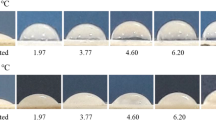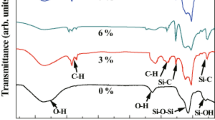Abstract
Superhydrophobic silica nanoparticles were prepared by hydrothermal-assisted sol–gel process using a two-step synthesis route. Silica nanoparticles were obtained by hydrolysis and condensation of tetraethyl orthosilicate (TEOS). Hexadecyltrimethoxysilane (HDTMS) was added to allow the condensation reaction between HDTMS hydroxyl group and silica hydroxyl group, rendering silica particles hydrophobic. Silica nanoparticles had a HDTMS/TEOS molar ratio of 2:40 and exhibited good hydrophobic property with a high water contact angle of 156.1°. Water droplet rolled off the surface of silica powder owing to a low sliding angle of 3.6°. When hydrothermal time of TEOS decreased from 120 to 60 min, all silica powders gave rise to high water contact angles (≥154.8°) and low sliding angles (≤5.5°). However, silica powder became hydrophilic when HDTMS and TEOS were added to the precursor together. This facile preparation of superhydrophobic silica nanoparticles with short reaction time provided the advantages for potential application in industrial production.

Highlights
-
Silica nanoparticles were synthesized by hydrothermal-assisted sol–gel process and hydrophobized using small amount of hexadecyltrimethoxysilane.
-
Short reaction time facilitates the efficient production of superhydrophobic silica powders.
-
Effects of hydrothermal time on surface modification of silica have been analyzed.









Similar content being viewed by others
References
Wang S, Jiang L (2007) Definition of superhydrophobic states. Adv Mater 19(21):3423–3424. https://doi.org/10.1002/adma.200700934
Nishimoto S, Bhushan B (2013) Bioinspired self-cleaning surfaces with superhydrophobicity, superoleophobicity, and superhydrophilicity. RSC Adv 3(3):671–690. https://doi.org/10.1039/c2ra21260a
Wagh PB, Ingale SV, Gupta SC (2010) Comparison of hydrophobicity studies of silica aerogels using contact angle measurements with water drop method and adsorbed water content measurements made by Karl Fischer’s titration method. J Sol Gel Sci Technol 55(1):73–78. https://doi.org/10.1007/s10971-010-2217-6
Guo Z, Liu W, Su B-L (2011) Superhydrophobic surfaces: from natural to biomimetic to functional. J Colloid Interface Sci 353(2):335–355. https://doi.org/10.1016/j.jcis.2010.08.047
Samaha MA, Tafreshi HV, Gad-el-Hak M (2012) Superhydrophobic surfaces: from the lotus leaf to the submarine. Comptes Rendus Mec 340(1-2):18–34. https://doi.org/10.1016/j.crme.2011.11.002
Mahadik SA, Kavale MS, Mukherjee SK, Rao AV (2010) Transparent superhydrophobic silica coatings on glass by sol-gel method. Appl Surf Sci 257(2):333–339. https://doi.org/10.1016/j.apsusc.2010.06.062
Deng X, Mammen L, Zhao Y, Lellig P, Muellen K, Li C, Butt H-J, Vollmer D (2011) Transparent, thermally stable and mechanically robust superhydrophobic surfaces made from porous silica capsules. Adv Mater 23(26):2962–2965. https://doi.org/10.1002/adma.201100410
Shang Q, Zhou Y (2016) Fabrication of transparent superhydrophobic porous silica coating for self-cleaning and anti-fogging. Ceram Int 42(7):8706–8712. https://doi.org/10.1016/j.ceramint.2016.02.105
Mahltig B, Arnold M, Loethman P (2010) Surface properties of sol-gel treated thermally modified wood. J Sol Gel Sci Technol 55(2):221–227. https://doi.org/10.1007/s10971-010-2236-3
Ebert D, Bhushan B (2012) Durable Lotus-effect surfaces with hierarchical structure using micro- and nanosized hydrophobic silica particles. J Colloid Interface Sci 368:584–591. https://doi.org/10.1016/j.jcis.2011.09.049
Nystrom D, Lindqvist J, Ostmark E, Antoni P, Carlmark A, Hult A, Malmstrom E (2009) Superhydrophobic and self-cleaning bio-fiber surfaces via ATRP and subsequent postfunctionalization. ACS Appl Mater Interfaces 1(4):816–823. https://doi.org/10.1021/am800235e
Su C (2010) Facile fabrication of a lotus-effect composite coating via wrapping silica with polyurethane. Appl Surf Sci 256(7):2122–2127. https://doi.org/10.1016/j.apsusc.2009.09.058
Hou H, Chen Y (2007) Preparation of super-hydrophobic silica films with visible light transmission using phase separation. J Sol Gel Sci Technol 43(1):53–57. https://doi.org/10.1007/s10971-007-1571-5
Li J, Zhao Z, Zhang Y, Xiang B, Tang X, She H (2016) Facile fabrication of superhydrophobic silica coatings with excellent corrosion resistance and liquid marbles. J Sol Gel Sci Technol 80(1):208–214. https://doi.org/10.1007/s10971-016-4076-2
Zhang F, Shi Z, Jiang Y, Xu C, Wu Z, Wang Y, Peng C (2017) Fabrication of transparent superhydrophobic glass with fibered-silica network. Appl Surf Sci 407:526–531. https://doi.org/10.1016/j.apsusc.2017.02.207
Park K-C, Choi HJ, Chang C-H, Cohen RE, McKinley GH, Barbastathis G (2012) Nanotextured silica surfaces with robust superhydrophobicity and omnidirectional broadband supertransmissivity. ACS Nano 6(5):3789–3799. https://doi.org/10.1021/nn301112t
Kong J-H, Kim T-H, Kim JH, Park J-K, Lee D-W, Kim S-H, Kim J-M (2014) Highly flexible, transparent and self-cleanable superhydrophobic films prepared by a facile and scalable nanopyramid formation technique. Nanoscale 6(3):1453–1461. https://doi.org/10.1039/c3nr04629j
Guo Q, Huang D, Kou X, Cao W, Li L, Ge L, Li J (2017) Synthesis of disperse amorphous SiO2 nanoparticles via sol-gel process. Ceram Int 43(1):192–196. https://doi.org/10.1016/j.ceramint.2016.09.133
Plumere N, Ruff A, Speiser B, Feldmann V, Mayer HA (2012) Stober silica particles as basis for redox modifications: particle shape, size, polydispersity, and porosity. J Colloid Interface Sci 368:208–219. https://doi.org/10.1016/j.jcis.2011.10.070
Dubey RS, Rajesh YBRD, More MA (2015) Synthesis and characterization of SiO2 nanoparticles via sol-gel method for industrial applications. Mater Today Proc 2(4-5):3575–3579. https://doi.org/10.1016/j.matpr.2015.07.098
Boday DJ, DeFriend KA, Wilson KV, Coder D, Loy DA (2008) Formation of polycyanoacrylate - silica nanocomposites by chemical vapor deposition of cyanoacrylates on aerogels. Chem Mater 20(9):2845–2847. https://doi.org/10.1021/cm703381e
Iliescu C, Chen B, Poenar DP, Lee YY (2008) PECVD amorphous silicon carbide membranes for cell culturing. Sens Actuators B Chem 129(1):404–411. https://doi.org/10.1016/j.snb.2007.08.043
Yun L, Zhao J, Kang XL, Du Y, Yuan XB, Hou X (2017) Preparation and properties of monolithic and hydrophobic gelatin-silica composite aerogels for oil absorption. J Sol Gel Sci Technol 83(1):197–206. https://doi.org/10.1007/s10971-017-4378-z
Torri C, Alba LG, Samori C, Fabbri D, Brilman DWF (2012) Hydrothermal treatment (HTT) of microalgae: detailed molecular characterization of HTT oil in view of HTT mechanism elucidation. Energy Fuels 26(1):658–671. https://doi.org/10.1021/ef201417e
Zhuang L, Ma B, Chen S, Hou X, Chen S (2015) Fast synthesis of mesoporous silica materials via simple organic compounds templated sol-gel route in the absence of hydrogen bond. Microporous Mesoporous Mater 213:22–29. https://doi.org/10.1016/j.micromeso.2015.04.007
Hu Y, Wei ZR, Wu B, Shen B, Dai Q, Feng PX (2018) Photoluminescence of ZnS: Mn quantum dot by hydrothermal method. AIP Adv 8(1). https://doi.org/10.1063/1.5010833
Takeda Y, Komori Y, Yoshitake H (2013) Direct stober synthesis of monodisperse silica particles functionalized with mercapto-, vinyl- and aminopropylsilanes in alcohol-water mixed solvents. Colloids Surf A Physicochem Eng Asp 422:68–74. https://doi.org/10.1016/j.colsurfa.2013.01.024
Bazula PA, Arnal PM, Galeano C, Zibrowius B, Schmidt W, Schueth F (2014) Highly microporous monodisperse silica spheres synthesized by the Stober process. Microporous Mesoporous Mater 200:317–325. https://doi.org/10.1016/j.micromeso.2014.07.051
Xue C-H, Jia S-T, Zhang J, Tian L-Q (2009) Superhydrophobic surfaces on cotton textiles by complex coating of silica nanoparticles and hydrophobization. Thin Solid Films 517(16):4593–4598. https://doi.org/10.1016/j.tsf.2009.03.185
Zhao J, Li Y, Sheng J, Wang X, Liu L, Yu J, Ding B (2017) Environmentally friendly and breathable fluorinated polyurethane fibrous membranes exhibiting robust waterproof performance. ACS Appl Mater Interfaces 9(34):29302–29310. https://doi.org/10.1021/acsami.7b08885
Wu C, Liu Q, Chen R, Liu J, Zhang H, Li R, Takahashi K, Liu P, Wang J (2017) Fabrication of ZIF-8@SiO2 micro/nano hierarchical superhydrophobic surface on AZ31 magnesium alloy with impressive corrosion resistance and abrasion resistance. ACS Appl Mater Interfaces 9(12):11106–11115. https://doi.org/10.1021/acsami.6b16848
Zhang L, Xue C-H, Cao M, Zhang M-M, Li M, Ma J-Z (2017) Highly transparent fluorine-free superhydrophobic silica nanotube coating. Chem Eng J 320:244–252. https://doi.org/10.1016/j.cej.2017.03.048
Wang Q, Zhang Q, Zhan X, Chen F (2010) Structure and surface properties of polyacrylates with short fluorocarbon side chain: role of the main chain and spacer group. J Polym Sci Part A Polym Chem 48(12):2584–2593. https://doi.org/10.1002/pola.24038
Tang W, Huang Y, Qing F-L (2011) Synthesis and characterization of fluorinated polyacrylate graft copolymers capable as water and oil repellent finishing agents. J Appl Polym Sci 119(1):84–92. https://doi.org/10.1002/app.32605
Krafft MP, Riess JG (2015) Per- and polyfluorinated substances (PFASs): environmental challenges. Curr Opin Colloid Interface Sci 20(3):192–212. https://doi.org/10.1016/j.cocis.2015.07.004
Smitha S, Shajesh P, Mukundan P, Warrier KGK (2008) Synthesis of mesoporous hydrophobic silica microspheres through a modified sol-emulsion-gel process. J Sol Gel Sci Technol 48(3):356–361. https://doi.org/10.1007/s10971-008-1803-3
Zhao Y, Xu Y, Wu D, Wei W, Sun Y, Al-Arifi ASN, Aouak T, Al-Othman ZA (2010) Hydrophobic mesoporous silica applied in GC separation of hexene isomers. J Sol Gel Sci Technol 56(1):93–98. https://doi.org/10.1007/s10971-010-2280-z
Sheng JL, Xu Y, Yu JY, Ding B (2017) Robust fluorine-free superhydrophobic amino-silicone Oil/SiO2 modification of electrospun polyacrylonitrile membranes for waterproof-breathable application. ACS Appl Mater Interfaces 9(17):15139–15147. https://doi.org/10.1021/acsarni.7b02594
Pipatchanchai T, Srikulkit K (2007) Hydrophobicity modification of woven cotton fabric by hydrophobic fumed silica coating. J Sol Gel Sci Technol 44(2):119–123. https://doi.org/10.1007/s10971-007-1609-8
Latthe SS, Hirashima H, Rao AV (2009) TEOS based water repellent silica films obtained by a co-precursor sol-gel method. Smart Mater Struct 18(9). https://doi.org/10.1088/0964-1726/18/9/095017
Bae GY, Min BG, Jeong YG, Lee SC, Jang JH, Koo GH (2009) Superhydrophobicity of cotton fabrics treated with silica nanoparticles and water-repellent agent. J Colloid Interface Sci 337(1):170–175. https://doi.org/10.1016/j.jcis.2009.04.066
Garcia N, Benito E, Guzman J, Tiemblo P (2007) Use of p-toluenesulfonic acid for the controlled grafting of alkoxysilanes onto silanol containing surfaces: preparation of tunable hydrophilic, hydrophobic, and super-hydrophobic silica. JACS 129(16):5052–5060. https://doi.org/10.1021/ja067987a
Santiago A, Gonzalez A, Iruin JJ, Fernandez-Berridi MJ, Irusta L (2012) Preparation of superhydrophobic silica nanoparticles by microwave assisted sol-gel process. J Sol Gel Sci Technol 61(1):8–13. https://doi.org/10.1007/s10971-011-2583-8
Acknowledgements
This work was supported by the National Natural Science Foundation of China (Grant 10902099) and the Natural Science Foundation of Zhejiang Province, China (Grant LY16E030007), 521 Talent Training Plan of Zhejiang Sci-Tech University.
Author information
Authors and Affiliations
Corresponding authors
Ethics declarations
Conflict of interest
The authors declare that they have no conflict of interest.
Electronic supplementary material
Rights and permissions
About this article
Cite this article
Gu, H., Zhang, Q., Gu, J. et al. Facile preparation of superhydrophobic silica nanoparticles by hydrothermal-assisted sol–gel process and effects of hydrothermal time on surface modification. J Sol-Gel Sci Technol 87, 478–485 (2018). https://doi.org/10.1007/s10971-018-4731-x
Received:
Accepted:
Published:
Issue Date:
DOI: https://doi.org/10.1007/s10971-018-4731-x




